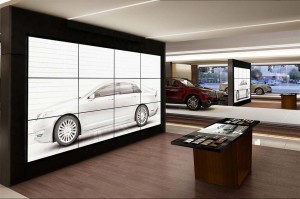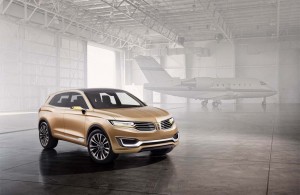It once vied with rival Cadillac for dominance in the huge U.S. luxury car market, but the last two decades have been tough for Lincoln. Sales have steadily slid to the point that some anticipate parent Ford Motor Co. might eventually abandon the once-grand marque.
Lincoln has rolled out several new products over the last two years, and it plans to add at least two more by 2016, but that’s a fraction of what rival Mercedes-Benz has in store – at least one all-new or completely updated product every three months through the end of the decade.
While Lincoln officials acknowledge they can’t keep up with that product blitz, they’re far from ready to admit defeat. But while they continue to struggle to find ways to lure more American buyers back to the brand, they’re looking East, towards China, to gain some much needed momentum.
“It’s strategically important for us to go to China,” said Matt Vandyke, Lincoln’s global director, a few days before the Ford luxury brand made its official debut at the 2014 Beijing Auto Show.
It is, if anything, difficult for many industry analysts to understand why Lincoln waited this long. China is already the world’s largest automotive market, and most forecasts project it will become the largest luxury car market, as well, before decade’s end. In fact, China is already the world’s largest source of sales for several major upscale brands, including both Audi and BMW.
(For full coverage of the 2014 Beijing Motor Show, Click Here.)
Lincoln actually already does have a modest presence in the country, as many as 10,000 so-called “gray market” vehicles being imported each year, largely to serve limousine fleets. But in the coming months, the maker’s first official showrooms will begin to open across the country.
Initially, there will be eight dealers in major cities that include capital Beijing and the economic center of Shanghai. Next year, the pace will begin to increase, with at least one new showroom opening each month. By the end of 2016, the goal is to have 60 Lincoln dealers in 50 cities across China.
Lincoln is, in many ways, following the same path that Toyota took when it launched the Lexus brand in the U.S. in 1989. It took the Ford subsidiary 15 months to line up what it insists are the best automotive retailers in China.
Unlike some of the modest facilities used by rival brands, each Lincoln showroom will be a large and lavish operation modeled, explained Vandyke, more along the lines of a luxury hotel lobby than a traditional showroom. There will be well-appointed lounges with coffee bars, and Lincoln’s products will be placed on pedestals, much like artwork. Dealers are also expected to each have at least one classic Lincoln product on display to enhance the sense of brand heritage.
Dealer staff, meanwhile, will undergo extensive training and there will be assigned duties, such as greeters and concierges, more like that luxury hotel experience. The dealerships will even have a special place for owners to wait and watch as repairs are being made.
It’s an approach Lincoln would like to eventually duplicate back home, though Vandyke acknowledged that with the brand’s U.S. dealers struggling, it would be a hard sell to get them to make the necessary investments. Longer-term, should the Chinese model work, he hopes to “cross-pollinate,” bringing some of those ideas back to the States.
While China has become the promised land for most of the world’s automakers, it can be challenging for new brands to make inroads, especially when up against such well-established marques as Audi and its parent Volkswagen AG, sales leaders, respectively, in the luxury and mainstream Chinese markets. But Lincoln does have some reason to be optimistic. Its own parent, Ford, was a relative latecomer to the booming market – but its sales have been growing at near-exponential rates, and the Ford Focus is now the single best-selling nameplate in the country.
In some ways, Lincoln’s own, belated launch could be a positive. It plans to start out with a relatively modest – but all-new range of products, notably including the MKZ sedan updated last year, and the compact MKC crossover to follow in 2015. Also on tap, a replacement for the MKX midsize crossover. A gold-colored prototype notably is making its debut during this week’s Beijing Auto Show.
(Click Here for a closer look at the MKX Concept.)
Lincoln isn’t the first American brand that has counted on China for survival, incidentally. By a historical fluke, General Motors went with the Buick brand when it started building cars in China at the turn of the Millennium. It is now one of the market leaders – and that, GM officials have said, is why Buick survived the maker’s 2009 bankruptcy while four other brands were scrapped.
If all goes according to plan, Lincoln officials are betting that they could soon become a significant player in the Chinese luxury market. In fact, Vandyke told TheDetroitBureau.com it is “absolutely possible” that China could soon become the brand’s single-largest global market, out-selling even the U.S.
(Ford revives the old Escort nameplate for China. Click Herefor the full story.)
While most analysts believe it is critical for Lincoln to expand beyond U.S. shores, not everyone is convinced the brand is on the comeback trail.
“The commitment for Lincoln isn’t really there,” asserted George Peterson, a former Ford analyst who now runs the AutoPacific, Inc. consultancy. There’s nowhere near enough product, he contends, deriding Ford’s commitment of $1 billion to support Lincoln as little more than “petty cash.”
Then again, a strong start in China could convince Ford to open up its pocketbook. Both current CEO Alan Mulally and his heir-apparent Mark Fields have hinted there could be more investments – read products — to come beyond 2016.
Also to be decided is whether Lincoln would eventually build vehicles in China. Initially, it plans to import all products from the U.S. which will subject them to a 25% tariff that could hurt their competitiveness – or reduce Ford’s profits if it decides to absorb some of that hit. Longer-term, industry analysts say Lincoln will have to copy the strategy of Chinese luxury leaders like Audi, BMW, Mercedes and, more recently, Cadillac, and start building vehicles in the country to sidestep those duties. The good news is that Ford already has a number of plants available and will be adding still more in China over the next several years.


